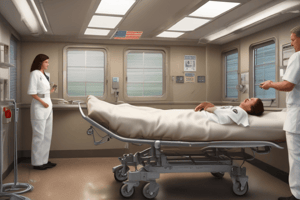Podcast
Questions and Answers
According to the National EMS Scope of Practice Model, an EMT should be able to:
According to the National EMS Scope of Practice Model, an EMT should be able to:
- Insert a peripheral IV line and infuse fluids.
- Interpret a basic (ECG) rhythm and treat accordingly.
- Administer epinephrine via the subcutaneous route.
- Assist a patient with certain prescribed medications. (correct)
An appropriate demonstration of professionalism when your patient is frightened, demanding, or unpleasant is to:
An appropriate demonstration of professionalism when your patient is frightened, demanding, or unpleasant is to:
- Ignore the patient's feelings and focus on his or her medical complaint.
- Reassure the patient that everything will be all right, even if it will not be.
- Demand that the patient be quiet and cooperative during transport.
- Continue to be nonjudgmental, compassionate, and respectful. (correct)
Continuing education in EMS serves to:
Continuing education in EMS serves to:
- Maintain, update, and expand the EMT's knowledge and skills. (correct)
- Provide an ongoing review and audit of the EMS system.
- Confirm research and statistical findings in prehospital care.
- Enforce mandatory attendance at agency-specific training.
EMS as we know it today had its origins in 1966 with the publication of:
EMS as we know it today had its origins in 1966 with the publication of:
If an EMT candidate has been convicted of a felony or misdemeanor, he or she should:
If an EMT candidate has been convicted of a felony or misdemeanor, he or she should:
Obtaining continuing medical education is the responsibility of the:
Obtaining continuing medical education is the responsibility of the:
The continuous quality improvement (CQI) process is designed to:
The continuous quality improvement (CQI) process is designed to:
The person who is responsible for authorizing EMTs to perform emergency medical care in the field is the:
The person who is responsible for authorizing EMTs to perform emergency medical care in the field is the:
The standards for prehospital emergency care and the individuals who provide it are typically regulated by the:
The standards for prehospital emergency care and the individuals who provide it are typically regulated by the:
Which of the following scenarios involves the administration of ALS?
Which of the following scenarios involves the administration of ALS?
Which of the following skills would a layperson MOST likely be trained to perform before arrival of EMS?
Which of the following skills would a layperson MOST likely be trained to perform before arrival of EMS?
Which type of medical direction do standing orders and protocols describe?
Which type of medical direction do standing orders and protocols describe?
What should an EMT do to limit errors in the field?
What should an EMT do to limit errors in the field?
Which of the following statements regarding the Americans with Disabilities Act (ADA) of 1990 is correct?
Which of the following statements regarding the Americans with Disabilities Act (ADA) of 1990 is correct?
You are caring for a driver who struck a light pole. She admits to drinking alcohol but orders you not to tell anyone. You should report the information to:
You are caring for a driver who struck a light pole. She admits to drinking alcohol but orders you not to tell anyone. You should report the information to:
Flashcards are hidden until you start studying
Study Notes
EMT Scope of Practice
- EMTs can assist patients with certain prescribed medications as per the National EMS Scope of Practice Model.
- EMTs do NOT have the authority to interpret ECG rhythms or insert IV lines.
Professionalism in Patient Care
- Maintain professionalism by being nonjudgmental, compassionate, and respectful, especially with frightened or unpleasant patients.
Continuing Education
- Continuing education is crucial for EMTs to maintain, update, and expand their knowledge and skills.
Historical Context of EMS
- Modern EMS originated in 1966 with the publication of "Accidental Death and Disability: The Neglected Disease of Modern Society."
Felony or Misdemeanor Convictions
- EMT candidates with felony or misdemeanor convictions must contact their state EMS office with the necessary documentation, as these convictions may affect licensure eligibility.
Responsibility for Continuing Medical Education
- Individual EMTs are responsible for obtaining their continuing medical education.
Continuous Quality Improvement (CQI)
- The CQI process aims to identify areas for improvement and provide remedial training when necessary.
Authority in Emergency Medical Care
- The medical director is responsible for authorizing EMTs to perform medical care in the field.
Regulation of Prehospital Care
- Standards for prehospital emergency care are typically regulated by the state office of EMS.
Advanced Life Support (ALS)
- Administration of ALS is indicated when airway security is achieved using a supraglottic device.
Layperson Training
- Laypersons are most likely to be trained in bleeding control techniques using a tourniquet before EMS arrival.
Medical Direction
- Off-line medical direction is described by standing orders and protocols.
Error Limitation
- EMTs should strictly follow written protocols to limit errors in the field.
Americans With Disabilities Act (ADA)
- The ADA prohibits discrimination against individuals with disabilities, ensuring equal employment opportunities.
Reporting Patient Information
- Any relevant information regarding a patient's alcohol consumption should be reported to the receiving nurse or doctor.
Studying That Suits You
Use AI to generate personalized quizzes and flashcards to suit your learning preferences.




